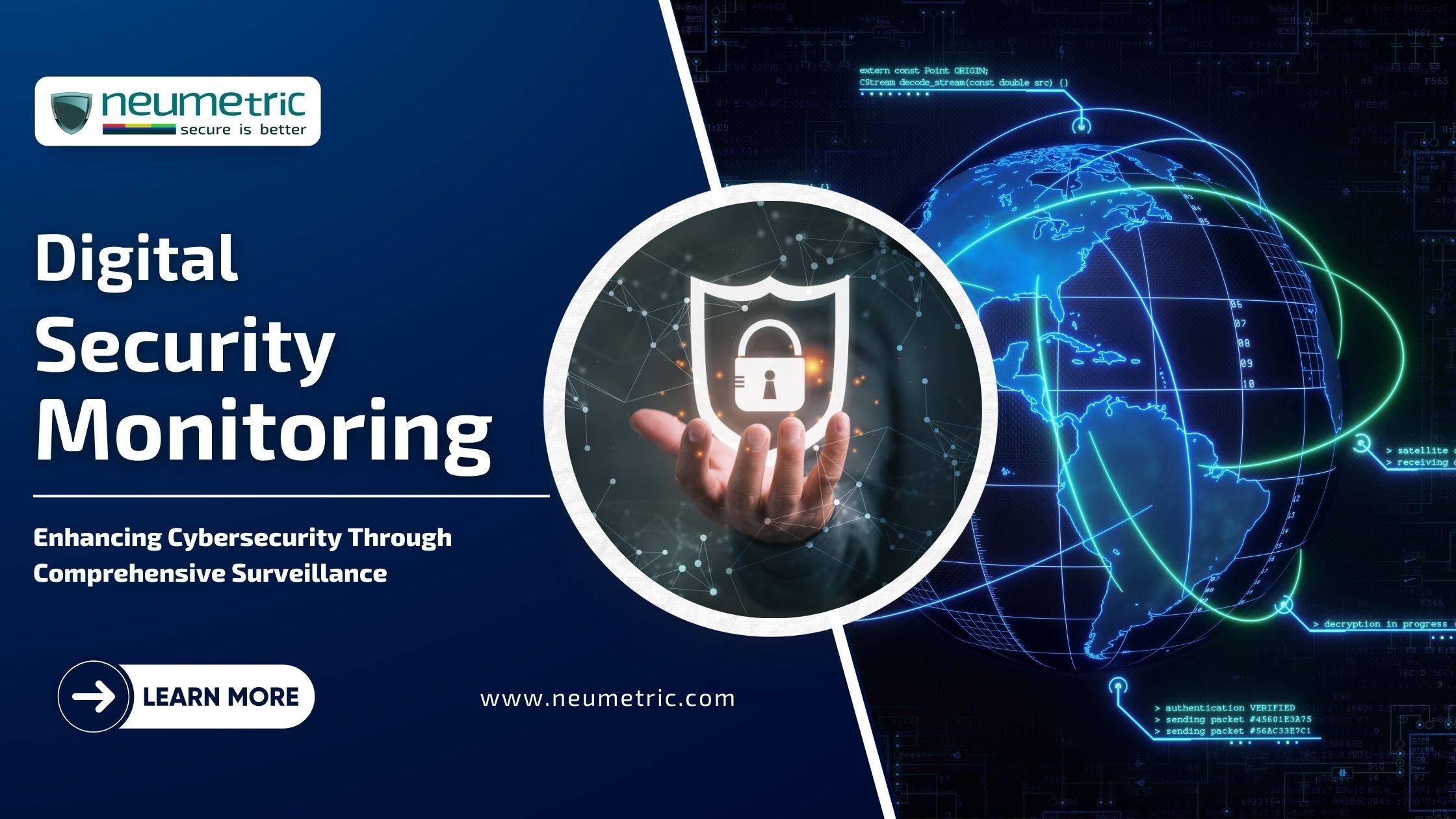Table of Contents
ToggleIntroduction
Digital security monitoring refers to the practice of monitoring & managing the security of digital systems & networks to protect them from unauthorised access, attacks or breaches. With the increasing reliance on technology & the rise in cyber threats, it has become essential for organisations & individuals to have effective security monitoring measures in place.
The goal of digital security monitoring is to detect & respond to security incidents in a timely manner, mitigating their impact & preventing further damage. This includes monitoring network traffic, system logs, user activities & other indicators of compromise to identify any suspicious or malicious activities.
Digital security monitoring as a proactive defence strategy is crucial in today’s evolving threat landscape. It helps organisations stay ahead of potential threats, detect & respond to security incidents promptly & continuously improve their security defences. By implementing proactive security measures, organisations can significantly reduce the risk & impact of cyber-attacks, protect sensitive information & maintain the trust & confidence of their stakeholders.
Understanding digital security monitoring
Digital security monitoring refers to the practice of monitoring & managing the security of digital systems & networks to protect them from unauthorised access, attacks or breaches. It involves the continuous monitoring & analysis of various security indicators, such as network traffic, system logs, user activities & security events.
The purpose of digital security monitoring is to detect & respond to security incidents in a timely manner, mitigate their impact & prevent further damage. The primary goals of digital security monitoring are early threat detection, incident response, compliance & regulatory requirements, vulnerability management & security incident Prevention.
Monitoring encompasses various aspects of an organisation’s digital environment, including network traffic, system logs, user activities, security events, cloud-based systems, applications & external threats.
Importance of digital security monitoring
Early threat detection: By constantly monitoring & analysing security indicators, organisations can identify potential security threats & breaches early. This allows for prompt action to mitigate the threat & minimise the impact.
Incident response: Digital security monitoring provides valuable data & insights that aid in investigating & responding to security incidents effectively. It helps in identifying the source of the attack, understanding the extent of the compromise & providing evidence for forensic investigations.
Compliance & regulatory requirements: Many industries have specific data protection & security regulations that require organisations to have robust security monitoring measures in place. Digital security monitoring helps organisations meet these compliance requirements & demonstrate due diligence in protecting sensitive data.
Vulnerability management: Security monitoring helps in identifying vulnerabilities & weaknesses in digital systems & networks. By analysing security events, organisations can identify patterns & trends that indicate potential risks & take proactive measures to address them. This includes implementing patches, updates & security configurations to strengthen security defences.
Security incident prevention: By continuously monitoring & analysing security indicators, organisations can proactively identify & address potential security threats before they materialise into actual incidents. It allows for the implementation of preventive measures such as network segmentation, access controls & user education to reduce the risk of successful attacks.
Components of digital security monitoring
Network monitoring: Tracking traffic & detecting anomalies
Network Monitoring plays a crucial role in tracking network traffic & detecting anomalies. It involves the collection, analysis & visualisation of network data to identify any abnormal or suspicious activities that may indicate a security threat. Here’s how network monitoring helps in tracking traffic & detecting anomalies:
Traffic analysis: This includes monitoring protocols, ports & IP addresses to understand the flow of data within the network. By monitoring traffic patterns, administrators can identify normal behaviour & flag any unusual or unexpected network traffic.
Intrusion detection: This uses various techniques such as signature-based detection, anomaly detection & behavioural analysis to identify potential intrusions or malicious activities.
Bandwidth monitoring: This helps administrators ensure efficient network performance & detect any abnormal spikes in traffic that may indicate a network issue or the presence of unauthorised activities.
Real-time alerts: These alerts are sent to administrators or security teams, allowing them to investigate & respond to potential security threats promptly. Alerts can be triggered for events such as unexpected traffic patterns, port scans, unauthorised access attempts or suspicious payload content.
Visualisation & reporting: Graphs, charts & dashboards display data such as top talkers, bandwidth utilisation & traffic trends, enabling administrators to quickly spot unusual patterns or spikes in network activity.
Endpoint monitoring: Monitoring devices for unusual behaviour
Endpoint monitoring is a security practice that involves continuous monitoring of devices, such as laptops, desktops, servers & mobile devices, to detect any unusual behaviour that signals a potential security threat. The goal of endpoint monitoring is to identify endpoint security events & respond to them in real-time before any damage is done. Endpoint monitoring involves several strategies, including:
Behaviour analysis: Endpoint monitoring tools analyse the behaviour of endpoints, such as usage patterns, software installations & network traffic to identify threats. By analysing & understanding what is ‘normal’ behaviour for an endpoint, the monitoring tool can detect anomalies & signals of compromise.
Threat intelligence: Endpoint monitoring solutions leverage threat intelligence feeds that provide real-time information about new threat actors & attack vectors. By analysing this information in conjunction with the endpoint data, the tool can identify & block threats as soon as they appear.
Asset inventory: Endpoint monitoring tools build a comprehensive inventory of endpoints, which helps with identifying when new or unexpected devices are detected. This helps in quickly identifying rogue or unknown devices, which can pose a major security risk.
Continuous monitoring: The endpoint monitoring tool continuously analyses endpoint activity, including network traffic, software usage & security events, to detect anomalies promptly. The tool can then generate alerts or block suspicious activities, preventing potential security breaches.
Application monitoring: Monitoring software applications for vulnerabilities
Application Monitoring involves the continuous monitoring & tracking of software applications to ensure their performance, availability & security. This monitoring practice focuses on detecting & resolving issues related to application performance, user experience & vulnerability management. Here’s an explanation of how application monitoring helps in monitoring software applications for vulnerabilities:
Performance monitoring: Application monitoring tools keep track of application performance metrics such as response time, CPU & memory usage & transaction throughput. By monitoring these metrics, administrators can identify any performance bottlenecks or issues that may affect the application’s availability or user experience.
Availability monitoring: Application monitoring tools monitor the availability of software applications by periodically sending automated requests to the application & monitoring the response. If the application becomes unavailable or experiences downtime, the monitoring tool can generate alerts, enabling administrators to take corrective actions promptly.
Security vulnerability monitoring: Application monitoring extends to monitoring for security vulnerabilities within software applications. This includes scanning applications to identify potential security weaknesses, vulnerabilities or misconfigurations. By regularly monitoring for these vulnerabilities, administrators can take preventive measures & apply security patches or updates to mitigate potential risks.
Log monitoring: Application monitoring tools capture & analyse log files generated by applications. By analysing logs, administrators can identify any abnormal or suspicious activities that may indicate a security incident or unauthorised access. This helps in detecting & responding to security threats promptly.
Real-time alerts & incident response: Application monitoring tools can generate real-time alerts when abnormalities, vulnerabilities or incidents are detected. These alerts are sent to administrators or security teams, enabling them to investigate & respond to potential security threats immediately.
User Activity Monitoring: Observing user behaviour & access patterns.
User Activity Monitoring [UAM] involves observing & recording the behaviour & access patterns of users within a digital environment. It provides organisations with insights into how users interact with systems, applications & data. Here’s how user activity monitoring helps in observing user behaviour & access patterns:
User behaviour analysis: User activity monitoring tools examine user behaviour & activities to establish a baseline of normal behaviour. By analysing the patterns of user actions, the monitoring tool can identify deviations that may indicate suspicious or malicious behaviour. This helps organisations detect & respond to potential insider threats or unauthorised access attempts.
Access control & compliance: User activity monitoring helps organisations ensure that users adhere to security policies, access controls & compliance regulations. It allows administrators to continuously monitor user activities to ensure that they have appropriate access privileges & are not engaging in unauthorised or risky behaviour.
Incident investigation & forensics: User activity monitoring tools capture detailed information, such as login times, application usage, file access & command executions. In the event of security incidents or violations, this information can be invaluable in conducting investigations & forensic analysis. It enables organisations to trace activities, identify the source of the incident & take appropriate actions against malicious or negligent users.
Data loss prevention: User activity monitoring plays a crucial role in identifying data exfiltration attempts. By monitoring & analysing user behaviour, organisations can detect patterns that indicate unauthorised attempts to access or transfer sensitive data. This helps in mitigating data loss risks & protecting sensitive information from being compromised.
Challenges & considerations
Balancing security with privacy concerns
Balancing security with privacy concerns is a crucial aspect of any digital security strategy. While it is important to protect digital assets & systems, it is equally important to respect individuals’ privacy rights. Here are some considerations for achieving a balance between security & privacy:
Privacy by design: Incorporate privacy considerations right from the beginning of system design & development. Ensure that privacy controls, such as data minimization, purpose limitation & user consent, are integrated into the design of systems & processes.
Data minimization: Only collect & retain the minimum amount of personal data necessary for the intended purpose. Adopt strict data retention policies to avoid excessive storage of personal information.
Access controls: Implement strong access controls & user authentication mechanisms to ensure that only authorised individuals have access to sensitive information. Regularly review & update access privileges to prevent unauthorised access.
Encryption: Utilise encryption techniques to protect the confidentiality & integrity of data. Implement end-to-end encryption for sensitive communications to minimise the risk of unauthorised access.
Transparency & communication: Be transparent with users about the data that is collected, how it is used & who has access to it. Clearly communicate privacy practices, policies & any security measures in place.
Consent & opt-in/opt-out: Obtain informed consent from users before collecting & using their personal data. Provide clear opt-in & opt-out mechanisms, allowing users to control the sharing & usage of their information.
Anonymization & pseudonymization: Where possible, de-identify personal data through anonymization or pseudonymization to reduce the risk of unauthorised identification & protect individual privacy.
Ensuring data accuracy & avoiding false positives
Ensuring data accuracy & avoiding false positives is essential for maintaining the integrity of digital security systems. False positives are occurrences where a security system incorrectly identifies a legitimate activity as malicious or unauthorised. Here are some strategies to help ensure data accuracy & reduce false positives:
Fine-tuning security tools: Regularly review & adjust the settings & thresholds of security tools, such as Intrusion Detection Systems [IDS] & anti-malware software, to minimise false positives. Configuring these tools to match the specific environment & user behaviour patterns can help improve accuracy.
Rule-based filtering: Implement rule-based filters to exclude known benign activities & patterns from generating alerts or triggering response actions. This approach helps eliminate false positives by specifically identifying expected behaviour.
Machine learning & AI: Leverage machine learning & artificial intelligence algorithms to analyse security data & identify patterns & anomalies. These technologies can help to identify legitimate activities more accurately & adaptively over time.
Human intervention: Integrate human analysis into the security workflow to review & validate alerts & potential incidents. Human expertise can provide insight & context to data that automated systems may not capture accurately.
Comprehensive logging & tracking: Maintain detailed logs & records of security events & activities. This enables comprehensive analysis & investigation of events, reducing the likelihood of false positives & aiding in accurate incident response.
Threat intelligence exchange: Collaborate with industry peers & security vendors to share threat intelligence & Indicators of Compromise [IoCs]. This helps to improve the accuracy of security tools & reduce false positives by leveraging shared information.
Resource allocation & managing the influx of data
Resource allocation & effectively managing the influx of data are crucial for ensuring the efficiency & effectiveness of digital security systems. Here are some strategies to help with resource allocation & data management:
Prioritisation: Prioritise security efforts based on risk assessments & the criticality of systems & data. Allocate resources to areas that pose the highest risks & the most valuable assets. This ensures that resources are utilised effectively to protect the most important aspects of the organisation.
Data governance: Establish clear data governance policies to define data classification, retention & disposal procedures. This ensures that data is managed efficiently & that only necessary data is retained, reducing the processing & storage burden.
Data analytics: Utilise data analytics techniques to extract valuable insights from security data. This can help identify patterns, detect anomalies & prioritise security incidents. By analysing & interpreting data effectively, resources can be allocated more efficiently based on actual risks & trends.
Scalability & elasticity: Implement scalable & elastic infrastructure to handle the influx of data & fluctuating workload demands. Cloud-based technologies & virtualization can provide the flexibility to dynamically allocate resources as needed.
Capacity planning: Regularly assess & plan for future resource needs based on data growth projections & business expansion. This helps to ensure that adequate resources are allocated to handle increasing data volumes & associated security requirements.
Highlighting specific threats detected & neutralised through monitoring
Threats that are often detected & neutralised through Digital Security Monitoring:
Malware & ransomware: Digital security monitoring can help identify & block malicious software or ransomware attacks. By monitoring network traffic & analysing file behaviour, security systems can detect & neutralise malware before it causes damage or spreads across the network.
Unauthorised access & insider threats: Monitoring user activities, login attempts & suspicious behaviour can help identify unauthorised access attempts & insider threats. Anomalies in user behaviour patterns, such as accessing unauthorised resources or attempting to escalate privileges, can be detected & addressed promptly.
Phishing & social engineering: Digital security monitoring systems can detect & block phishing emails, malicious links & suspicious communication attempting to deceive users. By analysing email headers, content & attachment behaviour, these systems can prevent phishing attacks & protect users from falling victim to social engineering tactics.
Denial-of-Service [DoS] & Distributed Denial-of-Service [DDoS] attacks: Security monitoring can identify & respond to DoS & DDoS attacks that aim to overwhelm network resources & disrupt services. Detection techniques can include monitoring traffic patterns, abnormal spikes in network activity & application layer anomalies.
Data leakage & exfiltration: Monitoring outbound network traffic & data transfers can help detect unauthorised data exfiltration attempts. By analysing network protocols, destinations & data patterns, security systems can quickly identify & block attempts to leak sensitive or confidential information.
Conclusion
In conclusion, digital security monitoring is crucial in today’s digital landscape to safeguard sensitive information, protect against cyber threats & ensure the smooth functioning & continuity of digital systems & networks. It enables organisations & individuals to stay one step ahead of potential security risks, detect & respond to threats effectively & maintain a strong security posture.
Adopting comprehensive monitoring strategies for proactive defence & incident response is essential to protect organisations against advanced cyber threats. By investing in robust monitoring solutions & frameworks, organisations can detect threats early, respond effectively, meet compliance requirements, enhance their resilience & safeguard sensitive data & user privacy.
FAQ:
What is security monitoring?
Security monitoring, also referred to as digital security monitoring involves collecting & analysing information to detect suspicious behaviour or unauthorised system changes on a network. It is a term for the process of detecting threats & managing security incidents. Security monitoring has two main phases: acquiring & analysing logs, data & indicators of security threats & responding with security risk remediation actions. It aims to identify potential security incidents, such as unauthorised access attempts or unusual behaviour & respond accordingly.
What are some examples of digital security?
Digital security encompasses various measures & practices to protect digital assets, data & systems from unauthorised access, misuse & threats. Here are some examples of digital security measures:
Strong passwords, Multi-Factor Authentication [MFA], firewall, virus & malware protection, encryption, secure network configuration, regular patching & updates, user access control, data backup & recovery, security awareness training, Intrusion Detection Systems [IDS], Intrusion Prevention Systems [IPS], Security Information & Event Management [SIEM], Data Loss Prevention [DLP], mobile device security, secure software development.
What is an example of a digital security measure?
One example of a Digital Security Measure is Multi-Factor Authentication [MFA]. MFA is a security mechanism that requires users to provide two or more forms of identification to access a digital system, application or network. The additional layer of authentication helps prevent unauthorised access even if the user’s password is compromised.
What are digital security methods?
Digital Security Methods refer to the various techniques & practices employed to protect digital assets, systems & data from unauthorised access, cyber threats & other security risks. Here are some commonly used digital security methods:
Vulnerability Assessment & Penetration Testing [VAPT], firewall, virus & malware protection, encryption, patch management, user access control, data backup & recovery, security awareness training, Intrusion Detection Systems [IDS], Intrusion Prevention Systems [IPS], Security Information & Event Management [SIEM], Mobile Device Management [MDM], cloud security.





